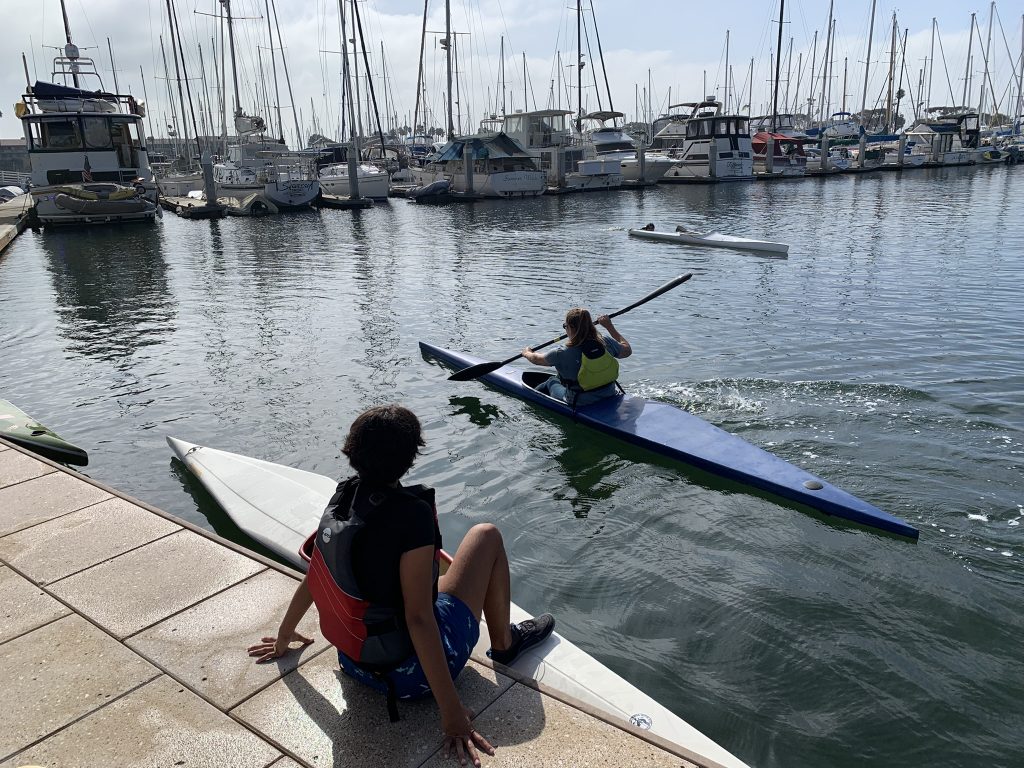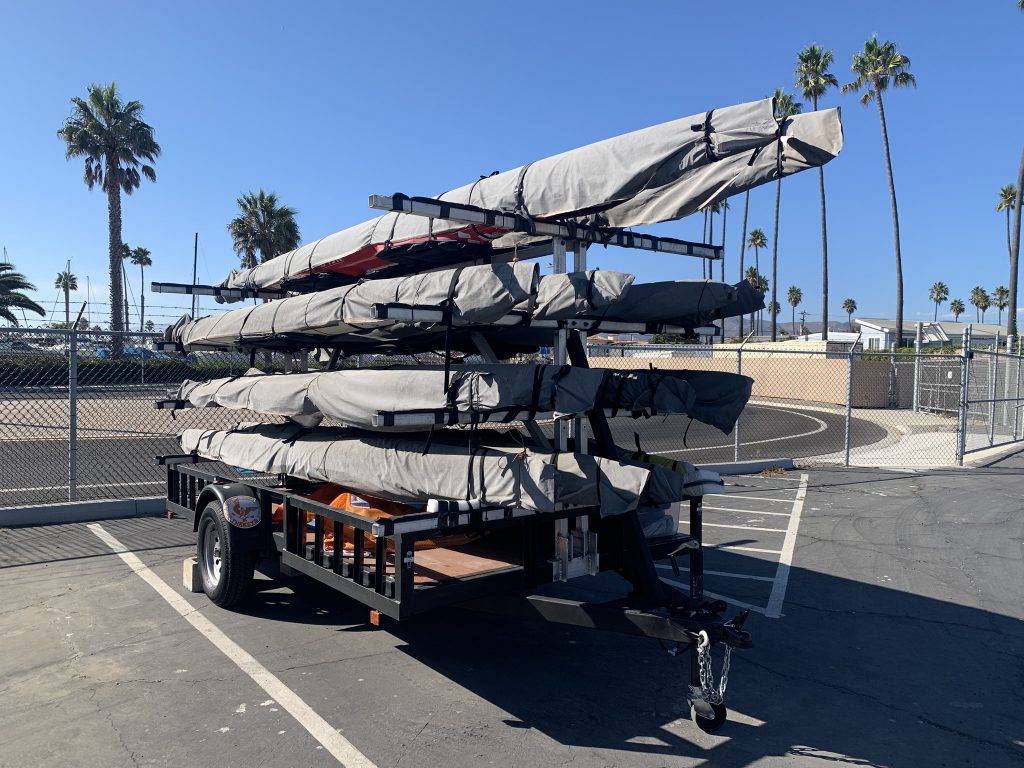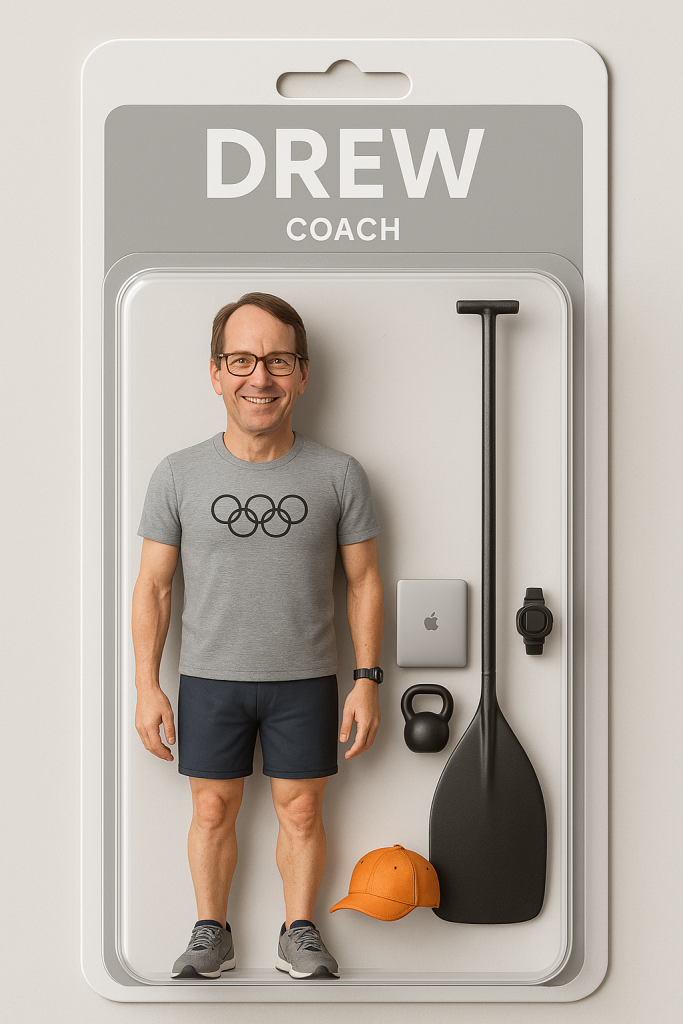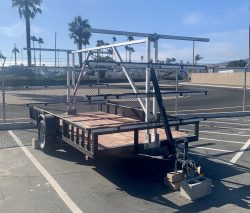Perhaps the title should include “in the United States of America” as the requirements are vastly different in other countries. The United States prioritizes sports played in our high schools, and especially sports that have collegiate and professional leagues like basketball, baseball, and American football. Most Americans have never heard of sprint canoe and kayak.
Coach Drew here. Ten years ago I began the task of recreating the Ventura Canoe & Kayak Club that Bill Bragg had run in my youth. (See my first post Re-birth of the Ventura Olympic Canoe Club.) It is hard to believe it has been an entire decade since I started this project.
The Covid-19 pandemic obviously put a kink in my plans. In the Fall of 2019, I had just moved to a part-time status (working only 3 days a week) with my job at Patagonia, and right before the March 13th shutdown, I was making presentations for some scheduled tryouts at the same middle school Coach Bragg had worked at and recruited nearly all of our club from back in the 1970s, 80s and early 90s. It’s not been easy to recruit (nor keep) sprint paddlers. Our club now has 10 active members and a couple of “remote” members who may join us at races from time to time.
This blog post will be my attempt to put into words the lessons learned about (re)starting a sprint paddling club and what I think it takes to do so in America.
Step One: Clearing Legal Hurdles
Efforts to build the club started slowly, and purposely, with the writing of our bylaws, getting our non-profit established, and then recruiting a Board for governance. Some other legal hurdles include:
- Opening a checking and savings account in the club’s name.
- Getting a domain name and building a website for the club.
- Procuring liability insurance, and possibly other coverage for equipment and assets.
- Developing marketing materials — posters, handouts, social media campaigns, merchandise with the club’s logo.
Any one of these items is a lot of work, and most are not free. I have donated at least a thousand of dollars each year over the past ten years, and while still working for Patagonia, I was able to take advantage of their generous matching offer for employee donations to nonprofits doubling my personal donations. It takes a fair amount of money to start a club, not just to keep one running.
Step Two: Getting Equipment

Buying new sprint boats is an expensive proposition. In 2025, a new single canoe or kayak will run in the neighborhood of $2,000, and new paddles can be as much as $500. You’ll also need a place to store and/or transport this equipment. I built racks on the side of my house that for several years held as many as 10 boats. My garage became home to paddles and other equipment.
Fortunately, I have been paddling sprint boats for close to fifty years, and was also part of a successful outrigger club for many years. Having these connections that go back so many years has provided us with a small army of supporters who also want to see a sprint club active in Ventura again. Sprint boats, paddles, surfskis, and even a trailer were donated to the club. Most equipment was in decent shape, some needed work. This was a huge help in getting the club started.
Step Three: Getting Access to Flat Water
Back in the 1970s and 80s, the club paddled in the Ventura Harbor in the mornings before school with paddlers riding in Coach Bragg’s van or in the cars of a couple of parents to Balboa Middle School where we would shower before running off to classes there or a couple of blocks away at Buena High School. Some of the club’s members lived closer to Coach in Newbury Park, Westlake, and Malibu Lake and had their own morning routines. Tuesday and Thursday evening, along with weekend practices, would be held at Westlake which was closer to Bragg’s home in Newbury Park. We had no problem getting access to these flat water areas.
Things have changed quite a bit since then. There are many restrictions today that make it harder to get access to freshwater locations. With the invasive species of quagga mussels now in California, access to lakes requires that boats be checked and cleared for use. Access to the Ventura Harbor is also more restricted due mostly to the area being more developed for commercial use. The use of the “public docks” where the club used to meet is not free and is often crowded. The Harbor Master was not happy with my first classes being run there.
With the help of the Portside Apartment development and an introduction by the Harbor Master, we have access to a dock in this newer marina that includes a public parking lot and beach volleyball courts. While we aren’t able to store our boats there (yet), we do have a good place to launch from and to meet for workouts. Many clubs struggle with this today and we are grateful to the management at Portside for their welcoming of our club.

Still, the Ventura Harbor is not an easy place to get to for Ventura youth. The 101 Freeway, and the very busy Harbor Boulevard, make access challenging for anyone without a car. There isn’t a bus service to this area either. Our youth paddlers must have the support of their family to drive them to and from our practices. Additionally, since the Harbor is not a “youth destination,” we don’t get the benefit of the club being seen regularly by our community as some other clubs do that meet at a lake in a city park or other highly visible location. Clubs in San Diego, Seattle, Gig Harbor, Oklahoma City, and Lake Lanier are ones that have access in very public and accessible areas, although they have also had to fight hard often to have and keep such access.
Ideally, a sprint club would have the ability to store boats, perhaps in a shipping container, a short distance from a public lake with a dock that is easily accessible to the community. This is a limitation we are still struggling to overcome.
Step Four: Recruiting Members
“Build it and they will come” may have worked in Field of Dreams, but it has not been our experience with our sprint club. I’ve done over 25 presentations at middle schools, had countless “tryout” classes, and held several “camps” for a week at a time, and in the process, learned a few things. First, adults are not likely going to be successful recruits to sprint unless they did the sport in their youth. Adults tend to be a “one-and-done” group. Also, the youth we get will require supportive families (see above) who can get their children to our practices. The youth needs to be the type of kid that wants to do something that is difficult and challenging, and also different from what other kids are doing. Most kids have a good time paddling – it’s a fun sport. But to get good at it and race competitively requires dedication and hard work. The ocean water is cold, and everyone tips over in the beginning.
Step Five: Managing Finances
Our club has been fortunate to have donations of equipment and money, and also a low “overhead” of costs that permits us to keep our club dues affordable to nearly everyone. (We currently have dues of $20 a month.) For the past six years, we’ve been renting a dry storage space to securely store our boat trailer a short distance from where we put in at the Ventura Harbor. The space has cost us only $95 a month. However, the fees will be going up to $135 a month starting in January! Our liability insurance and the dues we have to pay to the American Canoe Association, our sport’s National Governing Body, run about another $15 a month and are paid annually. Maintenance, web hosting, and legal filings for our nonprofit probably account for another $20 to $25 a month. Our dues do not cover all of our costs.
No one in the club is paid — we’re all volunteers and hope to keep it that way forever. If we had to pay salaries, most families in the area could not afford our sport. We’ve been able to keep our club dues low which helps the families we have save money for buying equipment of their own and to afford to go to our National Championships and Team Trials. Attending Nationals will cost at least $1,000 per paddler, and likely more. (Entrance fees and ACA dues alone are about a third of that expense.) Despite Ventura being a coastal community in California, much of our population won’t be able to easily cover these costs. Fundraising and getting financial donations is a requirement for all sprint clubs.
We spent money this year buying a new double kayak that will be more stable for beginners to use and a new utility trailer to replace the small and overloaded one that was donated years ago. Both of these investments will serve the club for many years, if not for decades.

The Bottom Line: Coaches and Support from the Community
Perhaps this should have been the first step in the list. It takes people willing to do all of this work, and coaches who know the sport, too. This is often just one person doing nearly everything for several years. Our club is lucky to have more than one volunteer working as a coach, a supportive Board that gives valuable input and support, a parent who has taken the time to do social media posts, and a community in the Ventura area that wants to see us be successful.
I recently found an archive of an article from the LA Times with the title “Rowing: Bragg developed the renowned Ventura Olympic Canoe Club for youngsters through the sheer force of his energy.” While our sport isn’t rowing, the article mentions a couple of club members who would be competing in the 1988 Olympics and had a good accounting of the club’s history. It also noted that there might be an end to the club as Bill Bragg had finally found a problem he couldn’t overcome; he was running out of energy. Even with his success of multiple national championships won by the club and members making Olympic teams, Coach Bragg was getting worn out. The National Championship trophy has many names of clubs that no longer exist. It definitely takes a supportive community to keep a club going.
So Dear Reader, thank you for taking the time to read our blog and we hope you’ll continue to support our club and the sport of sprint canoe and kayak. Let us know if you want help starting a club or if you can support ours!



